a&e features
‘Trump Survival Guide’ author on what to do now
From energy, education, LGBT issues and more, new book is road map for progressives

Feeling helpless in the impending Trump administration? Author Gene Stone is here to help with his new book “The Trump Survival Guide.”
The new book, out Jan. 10 from Dey Street Books (a HarperCollins imprint), is a trade paperback priced at $9.99 that’s subtitled “Everything You Need to Know About Living Through What You Hoped Would Never Happen.”
Bereft for about eight days after the Nov. 8 election, Stone, a New York Times bestselling author with 40 eclectic titles of several genres to his credit, says he couldn’t bear to watch or read the news. “Survival Guide” was written over the next 12 days (“I’ve had magazine deadlines that were much longer,” he says) with the help of seven co-writers.
Its chapters are devoted to topics like civil rights, the economy, education, energy, national security, LGBT issues and more. It’s billed as a “serious call to action for all anti-Trump dissenters across the political spectrum” that “succinctly analyzes crucial social and political policies, explains how Donald J. Trump has the power to undermine them and provides concrete practical solutions ordinary people can use to fight back.”
Stone spoke to the Blade by phone from his office in New York City. His comments have been slightly edited for length.
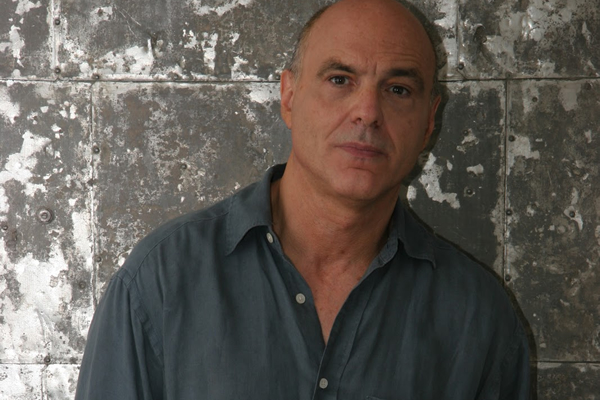
Author Gene Stone has written 12 books that have made the New York Times Bestseller list. Five hit No. 1. (Photo courtesy Dey Street Books)
WASHINGTON BLADE: How did you channel your election funk into this project so quickly?
GENE STONE: After about a week of feeling sorry for everything, I decided, you know — and this is the point of the book — it’s one thing to be depressed and mopey and God knows I have friends who are still crying, but you have to do something. Being depressed doesn’t get you anywhere. Being dejected and crying doesn’t solve anything. … Sitting around doing nothing accomplishes nothing. I thought, “Well, I have to do something.” I’m not the deepest thinker in the world, but I’m certainly one of the fastest and I realized I could do this. I knew that I could turn this book around in a short period of time. I have a pretty solid publishing history so I knew I had the credibility to get a book contract for something like this. They knew I was dependable, that I’d done it before and could do it again. All that meant that I should do the book, I could do the book so therefore I felt I had to do the book.
BLADE: How unusual is this tight of a turnaround time in the book publishing world?
STONE: There was a time years ago when instant books were much more common. Bantam Books was famous for being able to turn around books in a couple of weeks. … It has actually gotten much less common because the way those books were often sold was through the bookstores that would support the book, put it on their counters and make people aware of it that way, but as bookstores have less and less market share, it’s actually harder to get something like this out now. A book like this on a counter priced at $10 is a very appealing prospect that doesn’t quite have the same appeal on Amazon …. so it’s become less and less common.
BLADE: Obviously all the chapters were important to you but did the LGBT chapter have any special significance being gay yourself?
STONE: I can’t really say any were less important than the others but when it came time to do the book — I had some friends help me; I couldn’t do it all myself, so I hired a few friends to help write, research and fact check, etc. — but I needed right away to come up with a template for each chapter and the LGBT chapter was the one I wrote first myself the night I got the book contract staying up till God knows when in the morning in order to get the template done because frankly, it was a chapter I knew really well. … That established the pattern for the rest of the book.
BLADE: When you mention the agencies readers may want to support at the end of that chapter, you mention GLAAD, GLSEN, Lambda Legal and others but only sort of mention the Human Rights Campaign, the largest, under “and don’t forget …” Why?
STONE: (pauses) As you can tell, I have some issues there.
BLADE: You also wrote “The Bush Survival Bible.” Did his presidency end up being better or worse than you expected at the outset?
STONE: Well, they’re in fact much different books. The Bush book was actually kind of a funny book. A mix of satire and jokes and some serious advice, but in the guise of a funny book. When Bush won, I was also depressed, unhappy, I didn’t like it, but at least Bush was in the ballpark. I didn’t agree with it, but there was no sense that the world was going to be turned upside down. The Trump book is not a funny book, it’s a serious book because I do have a strong sense that there’s a possibility that the world could be turned upside down and there’s nothing funny about that.
BLADE: Are there any lessons we can glean from the Bush years as a sign of things to come or is it not analogous enough to justify that sort of thinking?
STONE: Well, again, even with that Republican administration, even though we disagreed with so many of their policies, it felt nonetheless that there was some kind of dialogue available between the right and the left …. but I’m not getting that feeling with the Trump administration. Obviously it hasn’t started yet, but in looking at his cabinet picks and watching his first press conference, I’m not getting the sense that things are going to seem as normal as they seemed during the Bush administration so it’s almost like you look back and think, “Gee, could it ever be worse?” and now you realize, “Oh man, it is worse. It’s much worse.” So I’m not sure the lessons we learned in the Bush years really apply because we’re dealing with an entirely new creature and I don’t think he is going to abide by the rules. Previously there’s been a norm in politics and civil discussion that both sides, with a bit of a stretch, have maintained. We’re not seeing that now and that’s one of the things that worries me most.
BLADE: Does Trump’s impulsiveness and reactionary personality lessen the value we would ordinarily perhaps glean from all the endless prognostication and tealeaf reading we see at the outset of any administration?
STONE: Two months ago, I probably would have said yeah, but now we have been seeing a fairly consistent pattern so I’m beginning to think the mixed signals from Trump are a thing of the past. What we’re seeing now is a pretty consistent formula of appealing to the alt right or right policies. We haven’t seen anything to the left or even the center so it’s been pretty consistent. It feels like the inconsistency of the past is melting into this kind of dreary consistency.
BLADE: Ideology aside, is that a good sign or do you still feel he could go off on some crazy limb at any point?
STONE: Yeah, the latter. Obviously we don’t know what’s going to happen till it happens, but all the signals so far have been pretty negative if not very negative.
BLADE: What do you think was the biggest factor in Hillary’s loss?
STONE: That’s something we always want to do in the media, and I’m as much to blame as anybody else, but we want to talk about the thing, the one thing, that made this happen but I would say it was really a combination of the Comey letter, perhaps faulty campaigning on her part, the country wanting change and any number of other factors. I really think it was the imperfect storm of factors and remember — she did win the popular vote. … It was very close. He’s also coming in with the lowest favorability ratings since polling began.
BLADE: By design, this book will have a short shelf life. Are you OK with that?
STONE: That’s just the nature of a book like this — nobody will be reading this in two years. I write a lot of books. I co-wrote a book on how not to die based on plant-based diets and it’s sort of an antidote to the major causes of death in America and I like to think that book will be around for many, many years to come. … I’d be very happy if all the sales of this book took place in the next six months. For the lessons here to be applied, people need to read the book now.
BLADE: There are a lot of things one could point to — eight years of Obama, the Obergefell ruling, the outcry from the Trayvon Martin case and so on, that made it feel like we’d really turned a corner on the straight, white, old boys’ club in politics then bam, in one fell swoop the old boys’ club came roaring back to win the White House and both chambers of Congress. Is it just that entrenched or something else?
STONE: It does speak to entrenchment yes, but it also points to another factor that’s been prevalent in American politics since the beginning, its back and forth nature. Carter to Reagan, Bush to Clinton, Clinton to Bush, Bush to Obama — it’s been a lot of back and forth. And also the fact that they barely made it in this time makes me hopeful. I mean here we had a centrist, liberal woman running with very, very negative favorability ratings and yet she came really close to winning. I also like to think that unless the damage Trump does to our democracy is really overwhelming, that the pendulum will eventually swing back again.
BLADE: Did progressives get too complacent? If this shakes us from our complacency, is that the silver lining?
STONE: I agree with that. I think liberals have a tendency to think that we’re right. We know what’s right, we’re kind and decent and empowering. That’s the way humans are supposed to be but unfortunately, that’s not the way all humans are. We did get very complacent having a terrific president for eight years and this is going to shock us out of our complacency and hopefully make us work in a way we saw the Tea Party work. As much as I don’t agree with anything they stood for, I admire the way they got their objectives into the policies of America and we need to do the same. If my book is really about anything, it’s about fighting back and finding ways to take on the Trump administration, not by waiting four years to vote against it, but by turning every day of your life into some kind of act of resistance. If there’s anything that’s going to make me happy, and I’ve heard it a few times already, it will be to hear people say, “I read your book and I joined an organization or I donated money or now I’m going to go march in the women’s protest. The point of the book is to try to get people to move.
BLADE: But how much can really be accomplished in this environment. How was the Tea Party able to become such a force while, say, the Occupy movement seemed like it had difficulty sustaining itself or harnessing that energy into something with any measurable impact? Is the right just better at mobilizing than the left? How can you be effective when you’re not the group in power at any given moment?
STONE: Well, I think one of the things that motivated the Tea party is that it didn’t have a titular head. You couldn’t say so-and-so ran everything because it was such a grass roots thing taking place in so many parts of the country. We need to learn from that. You don’t need a powerful leader. You don’t need a spokesperson. Every one of us can be a spokesperson just as everybody in the Tea Party felt they could go to the media and say whatever they wanted, we can do the same. … I also think politics tend to trickle up from the local level and we just don’t seem to get that. We get all excited about presidents and senators but it starts with local representatives and school boards. We just don’t seem to organize on the local level the way the Tea Party can do.

(Image courtesy Dey Street Books)
a&e features
Rehoboth’s Purple Parrot still soaring after 25 years
Owners Hugh Fuller and Troy Roberts reflect on keys to their success

Two buildings, one romance, and 25 years later, the Purple Parrot is busy as ever.
If the tropical purple paint covering the outside with rainbow flags and walls covered with love notes, affirmations, and drunk wishes scribbled on dollar bills don’t indicate it already, the Purple Parrot is an institution in Rehoboth. The gay-owned and operated fixture is celebrating its 25th anniversary this year.
The Blade sat down with owners Hugh Fuller and Troy Roberts of the Rehoboth establishment to discuss the past 25 years and plans for the future.
Fuller and Roberts, both gay, have been working together since before the Parrot was even an idea. Fuller was a co-owner of the Iguana, another restaurant and bar in the town.
“I was in the Iguana first with another business partner,” Fuller said. “I was going to get out and move up to Pennsylvania with him [Roberts]. He decided that he was going to come down and said, ‘Well, what if I go in with you at the Iguana and we do it together?’ And I was like, ‘Alright,’ so we did, and it just snowballed from there. We were always in the restaurant business together from the beginning.”
“Yeah, that was really luck, too,” Roberts began. “Because-”
“Because Grindr wasn’t around then!” Fuller interjected, laughing as Roberts began to roll his eyes and smile.
“I had a small place up in York,” Roberts continued. “Selling that kind of gave us some money to buy the other guy out. We just had friends supporting us and helping us along the way and it just kind of worked.”
“Kind of worked” would be an understatement. The pair moved on from the Iguana and opened the Parrot. Then, after opening the Parrot, they decided to shift locations to a larger location down the street to accommodate the growing demand. Then in 2010, the Parrot expanded again, adding the land behind the Rehoboth Avenue location, which provided an additional 950 square feet as well as giving patrons access to Wilmington Avenue.
The bar and restaurant, which serves American cuisine with a beach flair, has always focused on being a welcoming space to all regardless of sexuality, gender, race, nationality, or identity. This, the duo explains, is one of the reasons why the restaurant has had such a lasting impact on the Rehoboth restaurant and gay communities.
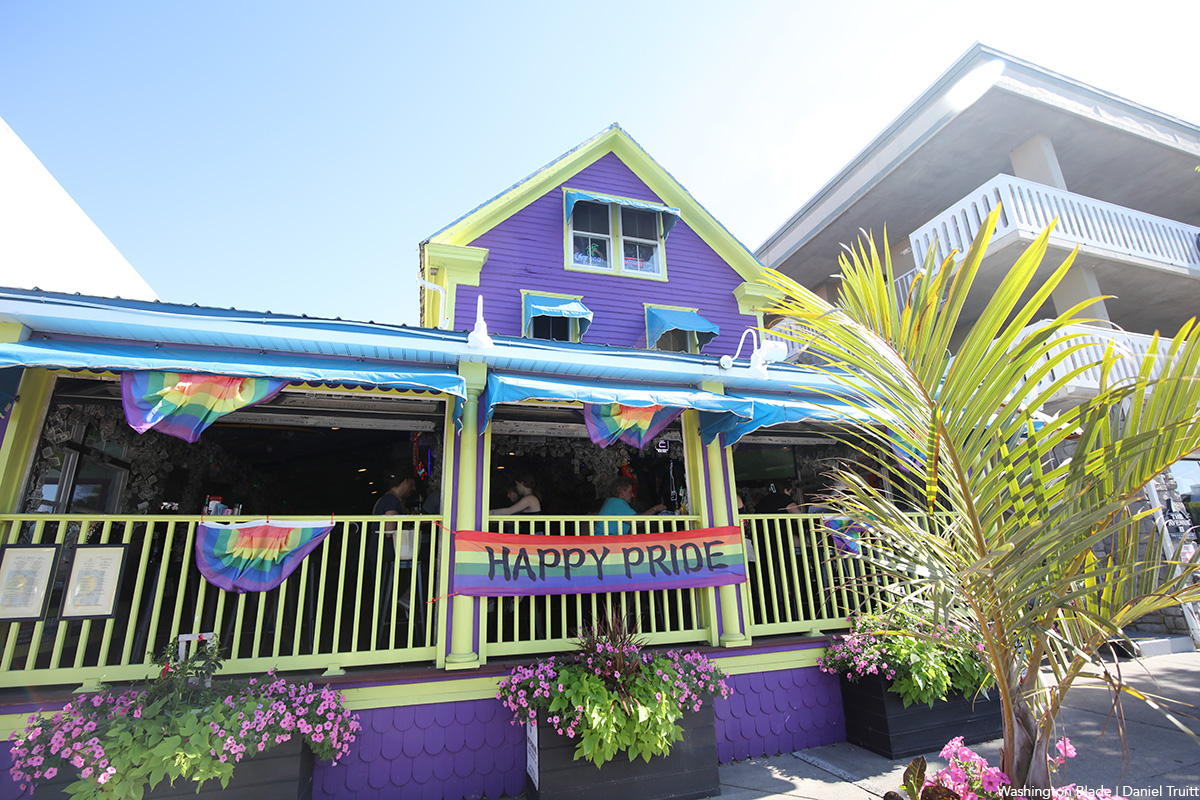
“Back in the ‘90s when we first opened up, the amount of straight crossdressers that would come were like, ‘Oh, are we allowed to come in? Are we welcomed into a place like that?’ And we were like ‘Everybody that walks on this planet is welcome here!’” Fuller said. “Those are the kinds of things, you know, where people just felt comfortable. They would get stared at out on the street, but inside they would walk around and feel like they were in their own skin. It was just really cool to see.”
The feeling of acceptance has been a crucial part of the Parrot’s success.
“I got an email a couple of days ago — probably two weeks ago about a woman bringing her daughter down,” Roberts said. “She’s 16 and was bullied through school — hard times, depression, tried to harm herself a couple of times. It was just really sweet that she reached out and she’s like, ‘My daughter was a completely different person when I brought her into your bar. Everybody treated her nice — the bartenders, the waitstaff, I mean, everybody was friendly. She just doesn’t experience that often being an out 16-year-old lesbian. We just can’t even thank you enough.’ It’s those kinds of things that we get often.”
“[The mother] mainly wrote it because we put the Pride flag on the Parrot’s Facebook wall,” Fuller added.
The colorful lights, disco balls, and staggering number of dollar bills stapled to the walls highlight that the Rehoboth community has embraced the Parrot. It’s not uncommon to see a group of gay patrons sitting at the bar in bathing suits sipping on orange crushes and talking about their day at Poodle Beach while a bachelorette party belts out Lady Gaga on karaoke night in the room next door. That is the vibe Fuller and Roberts have curated — a fun and friendly tropical oasis in the middle of Rehoboth Avenue.
A crucial element of this curated vibe, the pair point out, is treating employees and guests with respect. When asked what they have learned that helped them be so successful over the past 25 years, Fuller and Roberts said the same thing.
“Patience, organization, and treating people well,” Roberts said.” I think that’s probably one of the bigger of the three — you treat them well and they treat you well. I think it’s just a mutual respect.”
“It took me about 30 years to learn that it’s not just all about work,” Fuller said. “I used to bust my butt in there all the time and the focus was [on] the restaurant. I know [Roberts] said patience, I would say mine was being patient too because I learned going in that it’s easier to deal with your employees without shouting at them. It took me a little while to get through that.”
He added that compensating staff fairly was also one of their keys to success.
“Before we take a nickel out of our business, we put $1 back into our employees’ pockets,” Fuller said. We want the business to survive and it has been incredible.”
Fuller added that this sentiment, of having patience and treating everyone with respect, goes both ways — it applies to the Parrot’s patrons as well.
“If you leave the Parrot angry, it’s your own decision,” Fuller explained. “If we don’t make you happy there, it’s because you’re choosing not to be happy. We will go out of our way to correct anything and everything that we can. So if you leave [unhappy], it’s not because we couldn’t do it. It’s because you didn’t want us to.”
The two discussed their history together — anyone who has them interact can see their spirited energy and appreciation for each other.
“Troy and I used to be a couple when we first opened, and we were together for about 10 years,” Fuller said. “And then we kind of went our separate ways, but the restaurant kept us in very close contact. Sometimes I think we’re probably closer than most couples are because of the way that the restaurant has us tied together.”
“Even during the worst of it, we never stopped communicating on a daily basis,” Roberts added. “Obviously, you can tell by his personality why that all went south,” he said laughing.
“Well, you can tell by the way that he looks why it went south.” Fuller jabbed back, also laughing.
“Hey!” Roberts replied.
“I wasn’t gonna continue dating my grandfather!” Fuller joked.
Despite the end of their romantic relationship, there was still clear evidence of perpetual good energy between the business partners. The two then started to reminisce about the past 25 years and the struggles and successes they overcame to reach this milestone.
The pair mentioned the two biggest struggles they have faced in the past quarter century. One was when Rehoboth Avenue was dug up for the Streetscape improvement project, and the second was the 2008 recession.
“We were refinancing our houses several times to keep it afloat there for a little while,” Fuller said.
“But hey, we got nice sidewalks now!” Roberts added. “So that’s good.”
It’s not just the customers who grew up with the Parrot; so did the staff.
“I mean one of the kids who bussed for us is now our dentist,” Fuller said.
“One of the busboys from the Iguana days, he’s our dentist now,” Roberts explained. “They actually started dating in high school while working together at the Iguana. One of them followed us to the Parrot and her daughter just worked for us two summers ago as a host. He’s our dentist, and they’re still local. We just sold him a house over in Lewes, because we’re both Realtors on the side. When you look back at that, you’re like, ‘Oh, my God, you were just a kid. And now you have a kid graduating college!’ It goes fast.”
It seems that many of the staff have a soft spot for the Parrot, and for good reason. An important aspect of keeping their employees happy is supporting them. At first, it was trips to Disney World with some of the servers and renting out the local waterpark to give kids time to enjoy the summer. Then it became Christmas bonuses, which are not common in the food service industry.
The Parrot helped raise more than $10,000 for one of their employees dealing with fallout from the war in Ukraine.
“One of our bartenders being from Ukraine, when all that went down, amazingly, how he was able to bring a lot of his family over,” Roberts said. “And until they actually got grounded, he had places for them to stay all lined up.”
“The reason that he was able to get them over is because we did a fundraiser at the restaurant and our customers raised over $10,000 to help sponsor his family and one of our other employees’ families,” Fuller said. “They brought them all the way up through Mexico and into the country and now they’re here with citizenship cards and working for us. We got them houses and apartments too.”
“We don’t care what they are, whether they’re straight, Black, Chinese, Mexican. It’s like the Benetton of Rehoboth in here,” Fuller added. “It’s the United Nations. We support everybody and we’re not afraid to show our support for everybody.”
In addition to reminiscing about some of the good things the restaurant has done for its employees, they both talked about notable guests of the Parrot.
“My mind went right to the guys from Manhattan, who would always come down,” Roberts said when asked if any guests have stuck out to him over the past 25 years. “They just happened to find us. They had never been to Rehoboth before. They walked into the original Parrot and had every single year after that until two of them passed away. It just became like a yearly week, then it turned into two weeks, and then it turned into two times a year. And it was all just because they came to one bar, and had so much fun. They would sit there all day, all night, go home take a nap, and come back for dinner. And it was just their place.”
They have faced some objections from those who were not as receptive to their tolerance of different people.
“We get the same hate that everybody else does — the same hate that the city got when they put the rainbow crossings in and the flag up,” Fuller said. “I was just telling Troy about a conversation I had yesterday with a guy. The front of our business for Pride month has flags on it and says ‘Happy Pride.’ And he said, ‘I was going to come in here but I see you’re supporting the gay community with your rainbow flags.’ And I said ‘Yes.’ And he goes, ‘Well, I don’t see why you don’t have flags for veterans.’ And I said,’ Well, as a veteran, I can tell you that we don’t serve to be recognized, we serve to protect and to give you guys your freedom. It’s not something that we want recognition for. But there is a flag, the American flag, that flies over the top of our business every day to represent the veterans of this country.’”
Despite the opinions of some who are less than welcoming of the LGBTQ community, the Purple Parrot will always be a safe space to celebrate, the two affirmed. And celebrate they will.
The Parrot already hosted one party to celebrate the milestone of the bar early in the summer, but will throw an even bigger bash at the end of the season to commemorate the history and hard work that has gone into making the Parrot ‘fly.’
“On May fifth we had a big party,” Fuller said. “We’ll have another one at the end of the summer in September. We did one at the beginning and then we’re going to do a really big one at the end of the summer. The first celebration, that weekend, turned out to be a little rainy, and misty so it wasn’t as big as it could have been. It was packed inside but it wasn’t packed outside like it normally is. We usually do a full cookout barbecue, all that stuff and we’ll do that again at the end of the summer. We’ll have another one of those with DJs. I am not sure about a drag show, but we’ll probably have something because the girls are trying to get something together. We don’t want to spoil anything but there will be a surprise.”
When asked to give their final thoughts on owning and running one of Rehoboth’s most successful businesses as gay men, the two made it clear that it has to be a safe and welcoming space for all for it to succeed.
“I think you have to be all-inclusive,” Roberts said. “I don’t think in today’s world you can just really limit it to the gay community. You have to be gay-friendly, and accepting as well. And I think that helps because it gets non-gays in there and everybody just starts to get along. It becomes more accepted and then becomes the norm.”
Fuller agreed but emphasized being true to one’s character in collaboration with being inclusive is the key to their success.
“Being gay isn’t who we are, you know, it’s what we are,” Fuller said. “You can’t be afraid to be you. … If you’re going to open up a business, you want to make sure you lean on the community, because the community is going to be your biggest support. And that’s how we definitely lean on the gay community.”
The Purple Parrot is located at 134 Rehoboth Ave. in Rehoboth Beach and is open Monday through Saturday from 11 a.m. to 1 a.m. and is open from 9 a.m. to 1 a.m. on Sundays. For more information, visit their website at ppgrill.com.
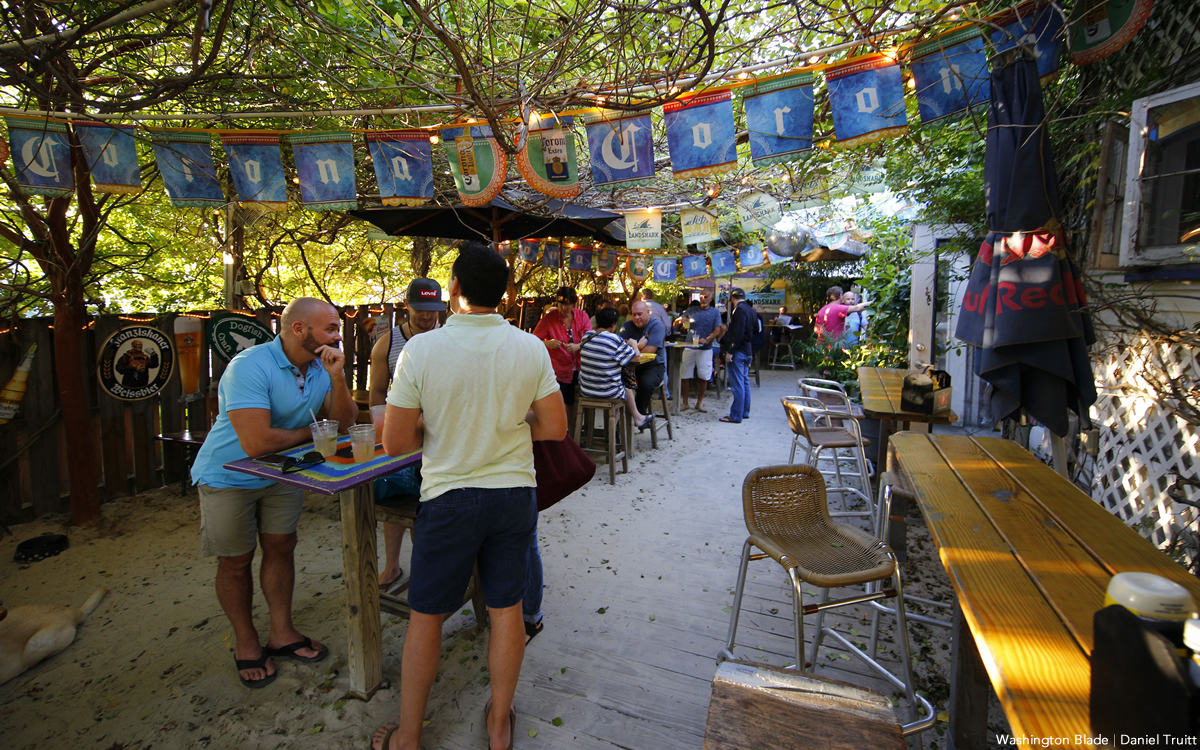
a&e features
Queer TV anchors in Md. use their platform ‘to fight for what’s right’
Salisbury’s Hannah Cechini, Rob Petree are out and proud in Delmarva
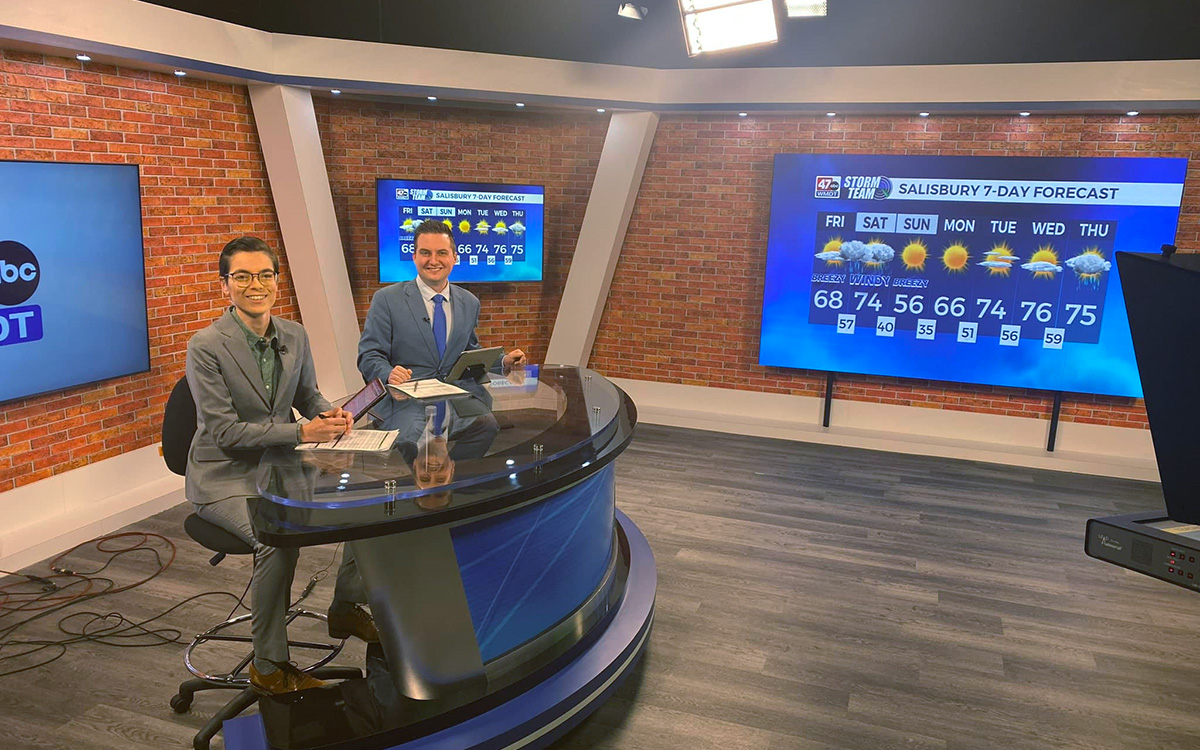
Identity can be a tricky thing for journalists to navigate. The goal of the job is to inform the public with no bias, but this is difficult, if not impossible, to do in practice. Everything from your upbringing to the books you read can impact how you view and cover the world. But sometimes these factors can help shine a light on an underrepresented community or issue.
Two broadcast journalists in Salisbury, Md., are using the subtle, yet impactful choice of sharing their queer identities to strengthen their reporting and connection to the community.
Hannah Cechini, who is non-binary, and Rob Petree, who is gay, co-host the 5:30-6:30 p.m. newscast for WMDT 47. They are the only known anchor team that are not only both queer, but also open out about their identities on air and, as Petree put it, “always use [their] platform and power that [we] have to fight for what’s right.”
Cechini’s passion for journalism played an important role in the discovery of their gender identity. They knew they were meant to be in the newsroom before they figured out they were non-binary.
“I was doing this job before I started to identify as non-binary,” Cechini told the Blade. “I’d always watch the evening news with my dad growing up and thought it was the coolest thing. And throughout high school, I worked on the school paper.”
After graduating from Suffolk University in Boston, Cechini’s passion for journalism only grew as they began to work in the world of news media, eventually ending up in Salisbury. As they honed their writing, editing, and anchoring skills at WMDT, Cechini also started to take an introspective look into their gender identity.
A little more than two years ago Cechini came out as non-binary to their coworkers in the newsroom and was met with support all around. “It was definitely smoother than I anticipated,” they said.
“It is very freeing to be able to do this job as a non-binary person because I haven’t really seen much of that representation myself.”
Petree, on the other hand, knew he was gay right around the same time he became interested in news media, at age 14. He started working for his high school news show and used it as a way to be open about his sexuality rather than hide it.
“I broke into broadcasting doing the morning announcements,” he said. “I did the weather and started doing a segment called issues and insights,” Petree said, explaining his introduction to the news. Eventually, students would ask him questions about his sexuality after seeing him on the school TV. “It had gotten to the point in school, that if you’re going to come up and ask me if I’m gay, well shit, I’m going to tell you!”
To him, this was the exact reason he had come out. Petree wanted to motivate others to live honestly.
“There are a lot of people who will spend most of their lives not being out so if they can see someone like me, who’s out and proud doing his thing, so to speak, then maybe that’s the inspiration for them,” Petree said. “To search their own soul, find out who they are, and live their full life.”
Petree explained that he got his start in a space that was not always welcoming to his queerness. This tested the delicate balance between being a journalist and holding your identity close.
“I’ve always been out and it was a challenge because I got my start in conservative talk radio,” Petree said. “I’m going to be honest, some of the things I heard from people I’ve worked with, from the callers to the radio stations were absolutely abhorrent. But I never let it discourage me. It made me work that much harder.”
Cechini highlighted the same sentiment when explaining why it’s important to have out LGBTQ figures in news media. They want to show everyone that it is possible to be openly queer and successful.
“I just think that representation matters because if ‘Joe,’ who’s never seen a transgender person before, sees a transgender person or a non-binary person, doing a job that they’ve only ever seen straight cis people doing before, it kind of creates that understanding or bridges that gap,” Cechini said. “It’s like, ‘OK, maybe they’re not that different from me.’ And that facilitates being able to connect among different communities.”
Both Cechini and Petree agree that having a queer coworker has made their bond stronger.
“It’s great to have someone else next to me who I can relate to and work alongside,” Petree said. “And they’re a joy to work with, they really are. There is a tremendous amount of things that we relate to together — like we both share and have the same affinity for Lady Gaga,” he said laughing. “Although they’re more of a Lady Gaga fan than I am.”
“Hannah is a tremendous journalist who really goes out of their way to make sure that the stories that they do are on point 100% of the time,” he added. “They’ve been great to work with and to learn from and to grow alongside. I’m very happy to have them as my co-anchor.”
Cechini explained that the relationship between two co-anchors can make or break a newscast, and having Petree as their partner on air is a major part of the show’s success.
“Co-anchoring is not just the relationship that you have on camera,” Cechini said. “It’s really, really important to have a good relationship with your co-anchor off-camera as well because you have to have a level of trust between you.”
Cechini continued, saying that this relationship is crucial to working together, especially when things don’t go as planned.
“Not everything always goes to script,” they said. “Sometimes you have to be able to work together without even really talking to each other and just kind of know what to do. When you have a relationship like that with someone who identifies similarly to you or has had similar life experience, I think that just only strengthens that [relationship].”
Although they have had similar experiences being from the LGBTQ community, Petree said it was a change for him to use “they/them” pronouns on air.
“Prior to working with Hannah, I’ve never worked with a non-binary individual who went by the pronouns ‘they/them,’” Petree said. “It was new for me to not use traditional pronouns on air, but I can say that I have never misgendered them on air and never will. You get conditioned to using traditional pronouns and it’s easy to make that mistake, but I never have.”
At the end of the day, they both explained, it is about doing the job right. For the duo, a part of that is understanding the diversity of people and issues in the community.
“When you come from a more marginalized community, I think that kind of helps to inform you a little better as a journalist because you have a better understanding of what it’s like to be ‘the other guy,’” Cechini said.
“Our talent and our drive for journalism speaks for itself,” Petree said. “And that resonates with people. Have we shown ourselves to be an inspiration to the LGBTQ+ community here in Delmarva? Yes, we have. And that’s something that I’m proud of.”
The primetime nightly newscast with Hannah Cechini and Rob Petree airs weeknights from 5:30-6:30 p.m. on ABC affiliate WMDT 47.
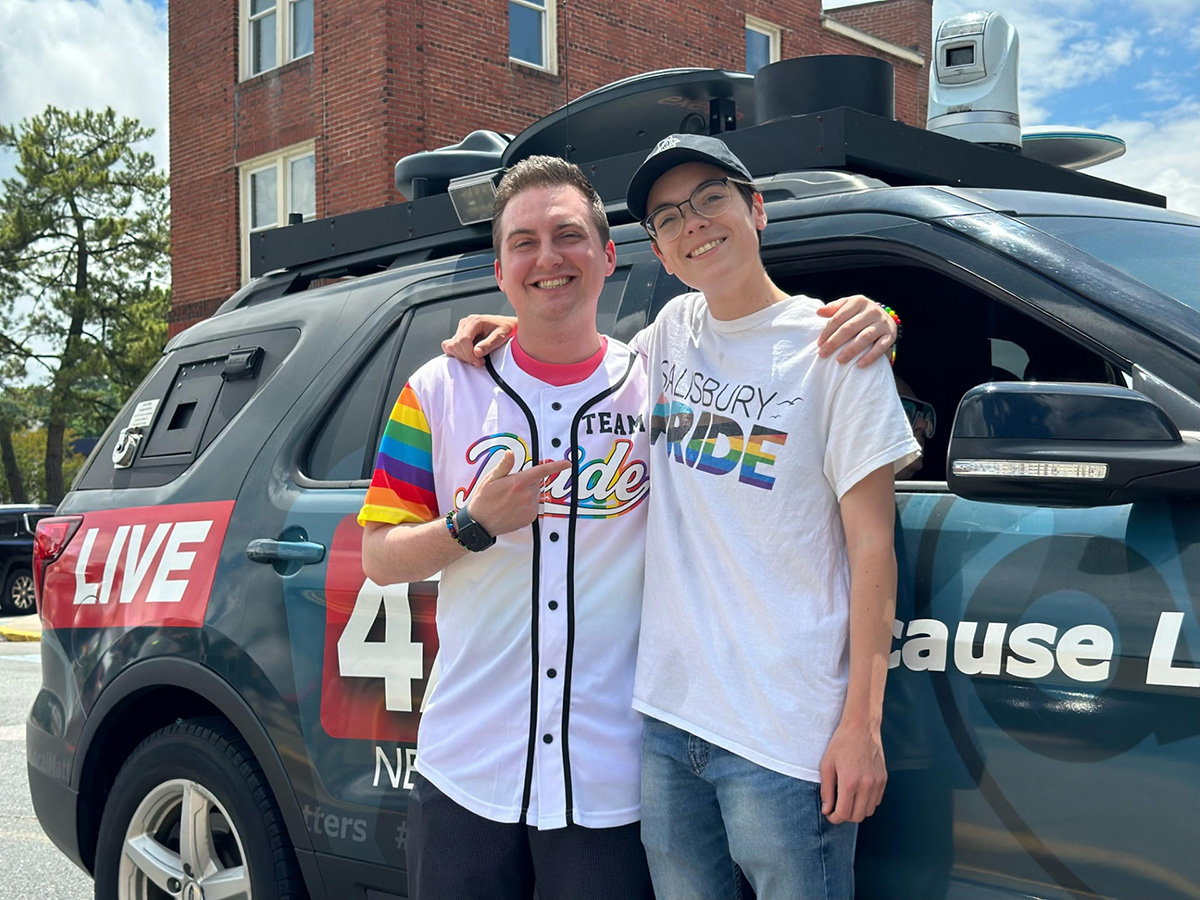
a&e features
‘Queering Rehoboth Beach’ features love, loss, murder, and more
An interview with gay writer and historian James T. Sears
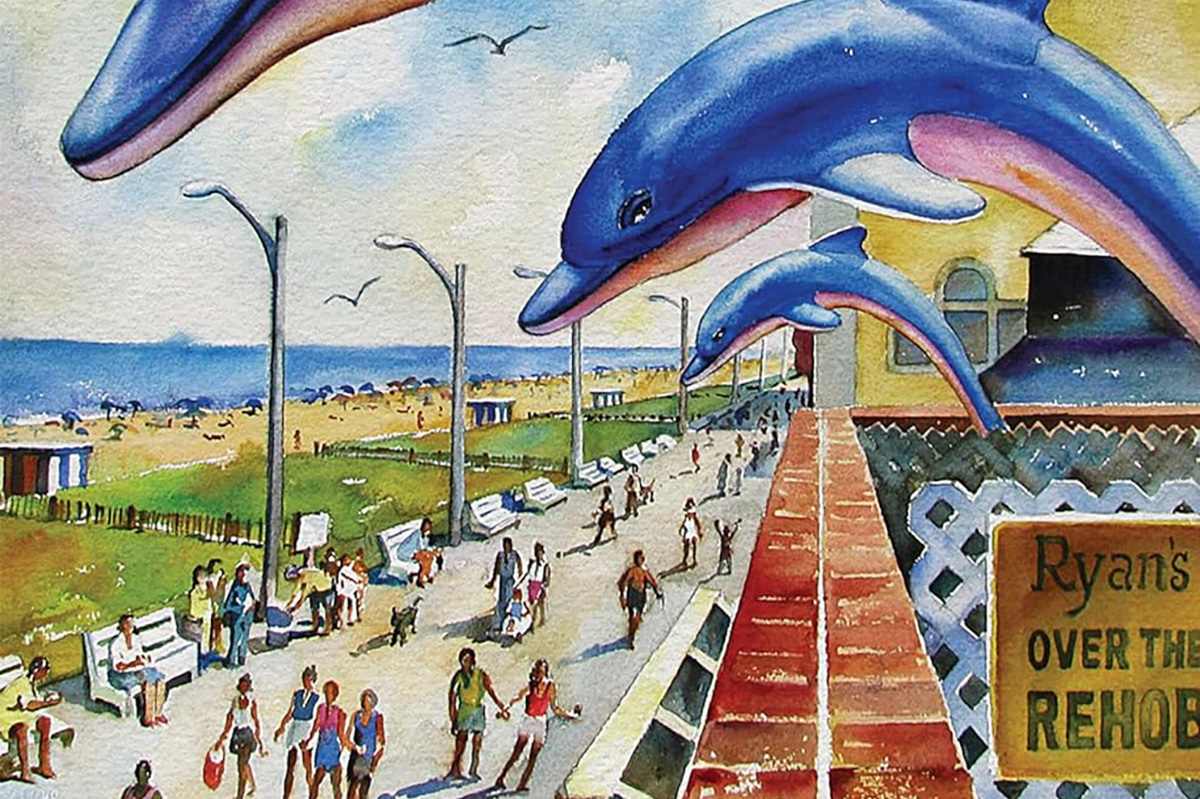
James T. Sears book talk
Saturday, June 29, 5 p.m.
Politics & Prose
5015 Connecticut Ave., N.W.
When it comes to LGBTQ summer destinations in the Eastern time zone, almost everyone knows about Provincetown, Mass., Fire Island, N.Y., and Key West, Fla. There are also slightly lesser known, but no less wonderful places, such as Ogunquit, Maine, Saugatuck, Mich., and New Hope, Pa. Sandwiched in between is Rehoboth Beach, Del., a location that is popular with queer folks from D.C., Maryland, Virginia, Pennsylvania, and New Jersey. The dramatic and inspiring story of how Rehoboth Beach came to be what it is today can be found in gay historian James T. Sears’s revealing new book “Queering Rehoboth Beach: Beyond the Boardwalk” (Temple University Press, 2024). As educational as it is dishy, “Queering Rehoboth Beach” provides readers with everything they need to know (and possibly didn’t realize they needed to know) about this fabulous locality. Sears was kind enough to make time to answer a few questions about the book.

WASHINGTON BLADE: James, it’s been a few years since I’ve interviewed you. The last time was in 1997 about your book “From Lonely Hunters to Lonely Hearts: An Oral History of Lesbian and Gay Southern Life.” At the time, you were living in Columbia, S.C. Where are you currently based, and how long have you been there?
JAMES T. SEARS: It has been great reconnecting with you. After that book, we moved to Charleston, S.C. There I wrote several more books. One was about the Mattachine group, focusing on one largely misunderstood leader, Hal Call. Another book shared reminisces of a 90-year-old gentleman, the late John Zeigler, interweaving his diaries, letters, and poetry to chronicle growing up gay in the South at the turn of the last century. From there I moved to Central America where I chronicled everyday queer life and learned Spanish. We returned several years ago and then washed up on Rehoboth Beach.
BLADE: In the introduction to your new book “Queering Rehoboth Beach: Beyond the Boardwalk” (Temple University Press, 2024), you write about how a “restaurant incident” in Rehoboth, which you describe in detail in the prologue, became a kind of inspiration for the book project. Please say something about how as a historian, the personal can also be political and motivational.
SEARS: I want to capture reader’s interest by personalizing this book more than I have others. The restaurant anecdote is the book’s backstory. It explains, in part, my motivation for writing it, and more crucially, introduces one meaning of “queering Rehoboth.” That is, in order to judge this “incident”—and the book itself—we need to engage in multiple readings of history, or at least be comfortable with this approach. I underscore that what is accepted as “history”—about an individual, a community, or a society—is simply a reflection of that era’s accepted view. Queering history challenges that consensus.
BLADE: Who do you see as the target audience for “Queering Rehoboth Beach?”
SEARS: Well, certainly if you have been to Rehoboth or reside there, this book provides a history of the town—and its queering—giving details that I doubt even locals know! Also, for those interested in the evolution of other East Coast queer resorts (Ptown, Fire Island, Key West) this book adds to that set of histories. My book will also be of interest to students of social change and community organizing. Most importantly, though, it is just a good summer read.
BLADE: “Queering Rehoboth Beach” features numerous interviews. What was involved in the selection process of interview subjects?
SEARS: I interviewed dozens of people. They are listed in the book as the “Cast of Narrators.” Before these interviews, I engaged in a systematic review of local and state newspapers, going back to Rehoboth’s founding as a Methodist Church Camp in 1873. I also read anecdotal stories penned by lesbians and gay men. These appeared in local or regional queer publications, such as Letters from CAMP Rehoboth and the Washington Blade. Within a year, I had compiled a list of key individuals to interview. However, I also interviewed lesbians, gay men, transgender individuals, and heterosexuals who lived or worked in Rehoboth sometime during the book’s main timeframe (1970s-2000s). I sought diversity in background and perspective. To facilitate their memories, I provided a set of questions before we met. I often had photos, letters, or other memorabilia to prime their memories during our conversation.
BLADE: Under the heading of the more things change, the more they stay the same, the act of making homosexuality an issue in politics continues to this day. What do you think it will take for that to change?
SEARS: You pose a key question. Those who effectuated change in Rehoboth — queers and progressive straights — sought common ground. Their goal was to integrate into the town. As such, rather than primarily focus on sexual and gender differences, they stressed values held in common. Rather than proselytize or agitate, they opened up businesses, restored houses, joined houses of worship, and engaged in the town’s civic life.
To foster and sustain change, however, those in power and those who supported them also had to have a willingness to listen, to bracket their presuppositions, and to engage in genuine dialogue. Violent incidents, especially one on the boardwalk, and the multi-year imbroglio of The Strand nightclub, gradually caused people to seek common ground.
That did not, however, come without its costs. For some — long separated from straight society — and for others — unchallenged in their heteronormativity — it was too great of a cost to bear. Further, minorities within the queer “community,” such as people of color, those with limited income, and transgender individuals, never entered or were never invited into this enlarging public square.
The troubles chronicled in my book occurred during the era of the “Moral Majority” and “Gay Cancer.” Nevertheless, it didn’t approach the degree of polarization, acrimony, fake news, and demagoguery of today. So, whether this approach would even be viable as a strategy for social change is debatable.
BLADE: In recent years, there has been a proliferation of books about LGBTQ bars, a subject that is prominent in “Queering Rehoboth Beach.” Was this something of which you were aware while writing the book, and how do you see your book’s place on the shelf alongside these other books?
SEARS: Queering heterosexual space has been a survival strategy for generations of queer folks. These spaces — under-used softball fields, desolate beaches, darkened parks, and out-of-the-way bars — are detailed in many LGBTQ+ books, from the classic, “Boots of Leather, Slippers of Gold,” to the recently published “A Place of Our Own” and “The Bars Are Ours.” Of course, these spaces did not encompass the kaleidoscope of queer life, but they provide us a historical gateway into various segments of a queer community and culture.
This was certainly true for my book. Unsurprisingly, until The Strand controversy, which began in 1988, all of Rehoboth’s queer bars were beyond the town limits. There were, however, homosexual watering holes in the liminal sexual space. For instance, you had the Pink Pony on the boardwalk during the 1950s and the Back Porch Café during the 1970s. So, in this sense, I think “Queering Rehoboth Beach” fits well in this ever-enlarging canon of queer history.
BLADE: As one of the most pro-LGBTQ presidents in U.S. history, how much, if it all, did the Biden Delaware connection have to do with your desire to write “Queering Rehoboth Beach?”
SEARS: It is just a coincidence. Interestingly, as I was researching this book, I came across a 1973 news story about Sen. Joe Biden speaking at a civic association meeting. One of the 30 or so residents attending was James Robert Vane. The paper reported the senator being “startled” when Vane questioned him about the ban on homosexuals serving in the U.S. civil service and military. Uttering the familiar trope about being “security risks,” he then added, “I admit I haven’t given it much thought.” In Bidenesque manner, he paused and then exclaimed, “I’ll be darned!”
Biden was a frequent diner at the Back Porch Café, often using the restaurant’s kitchen phone for political calls. Like the progressives I spoke about earlier, he had lived in a heteronormative bubble—a Catholic one at that! Yet, like many in Rehoboth, he eventually changed his view, strongly advocating for queer rights as Vice President during the Obama administration.
BLADE: How do you think Rehoboth residents will respond to your depiction of their town?
SEARS: Well, if recent events are predictive of future ones, then I think it will be generally positive. My first book signing at the locally owned bookstore resulted in it selling out. The manager did tell me that a gentleman stepped to the counter asking, “Why is this queer book here?”— pointing to the front table of “Beach Reads.” That singular objection notwithstanding, his plan is to keep multiple boxes in stock throughout the summer.
BLADE: Over the years, many non-fiction and fiction books have been written about places such as Provincetown, Fire Island, and Key West. Is it your hope that more books will be written about Rehoboth Beach?
SEARS: My hope is that writers and researchers continue to queer our stories. Focusing on persons, events, and communities, particularly micro-histories, provides a richer narrative of queer lives. It also allows us to queer the first generation of macro-histories which too often glossed over everyday activists. So, as the saying goes, let a thousand flowers bloom.
BLADE: Do you think that “Queering Rehoboth Beach” would make for a good documentary film subject?
SEARS: Absolutely, although probably not on the Hallmark Channel [laughs]! It would make an incredible film — a documentary or a drama — even a mini-series. Because it focuses on people: their lives and dreams, their long-running feuds and abbreviated love affairs, their darker secrets, and lighter moments within a larger context of the country’s social transformation. “Queering Rehoboth Beach” details the town’s first gay murder, the transformation of a once homophobic mayor, burned-out bars, and vigilante assaults on queers, the octogenarian lesbian couple, living for decades in Rehoboth never speaking the “L word,” who die within months of one another. It, too, is a story of how the sinewy arms of Jim Crow affected white Rehoboth — gay and straight. In short, “Queering Rehoboth Beach” is about a small beach town, transformed generation over generation like shifting sands yet retaining undercurrents of what are the best and worst in American life and culture.
BLADE: Have you started thinking about or working on your next book?
SEARS: The manuscript for this book was submitted to the publisher more than a year ago. During that time, I’ve been working on my first book of fiction. It is a queer novel set in early nineteenth century Wales against the backdrop of the Napoleonic wars and industrialization. I want to transport the reader into an era before the construction of homosexuality and at the inception of the women’s movement. How does one make meaning of sexual feelings toward the same gender or about being in the wrong gender? In the process of this murder mystery, I integrate Celtic culture and mythology and interrogate how today’s choices and those we made in the past (and in past lives) affect our future and those of others.
The Blade may receive commissions from qualifying purchases made via this post.
-

 Canada2 days ago
Canada2 days agoToronto Pride parade cancelled after pro-Palestinian protesters disrupt it
-

 Baltimore4 days ago
Baltimore4 days agoDespite record crowds, Baltimore Pride’s LGBTQ critics say organizers dropped the ball
-

 Sports4 days ago
Sports4 days agoHaters troll official Olympics Instagram for celebrating gay athlete and boyfriend
-

 U.S. Supreme Court1 day ago
U.S. Supreme Court1 day agoConcern over marriage equality in US grows two decades after first Mass. same-sex weddings











